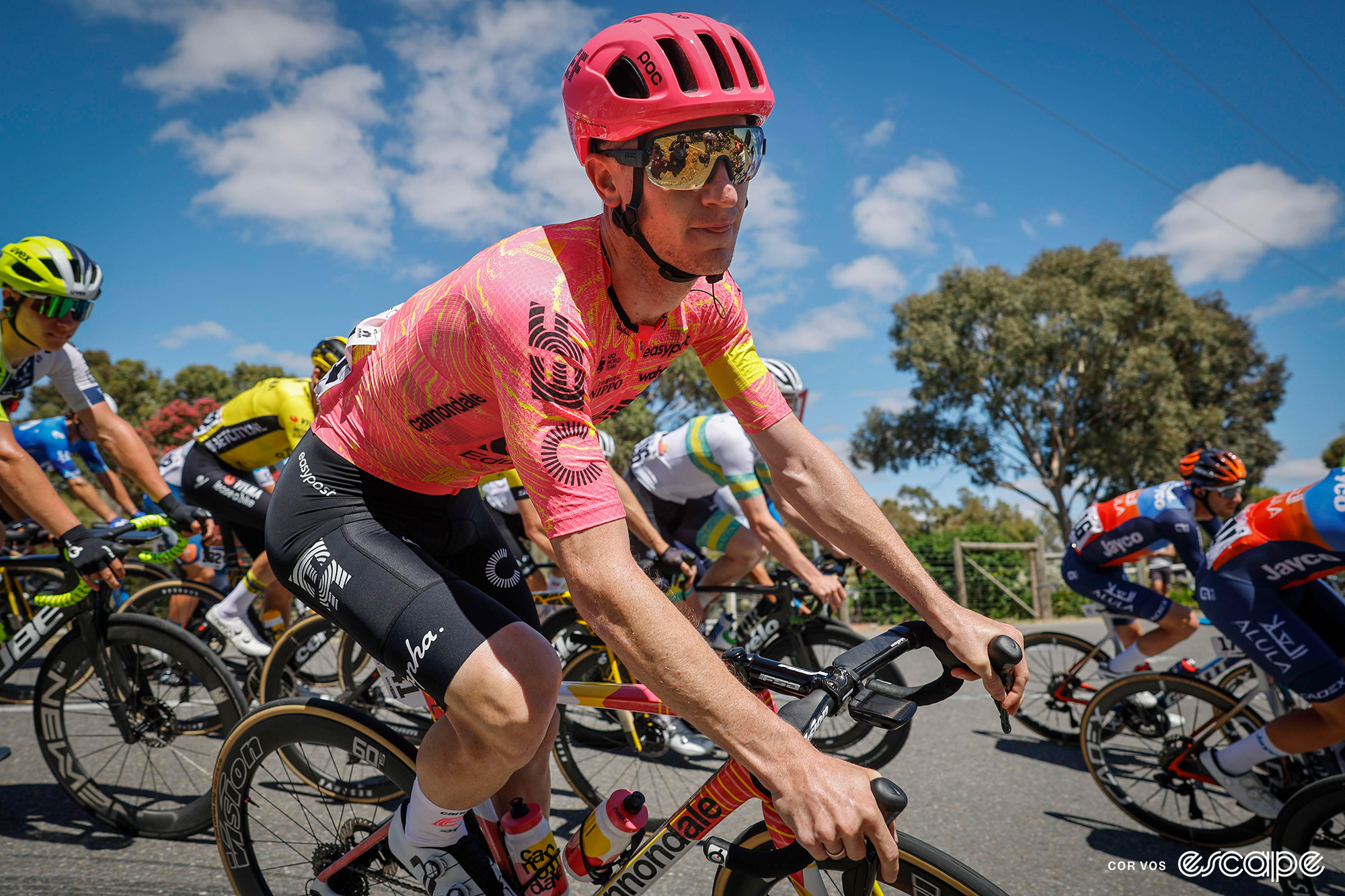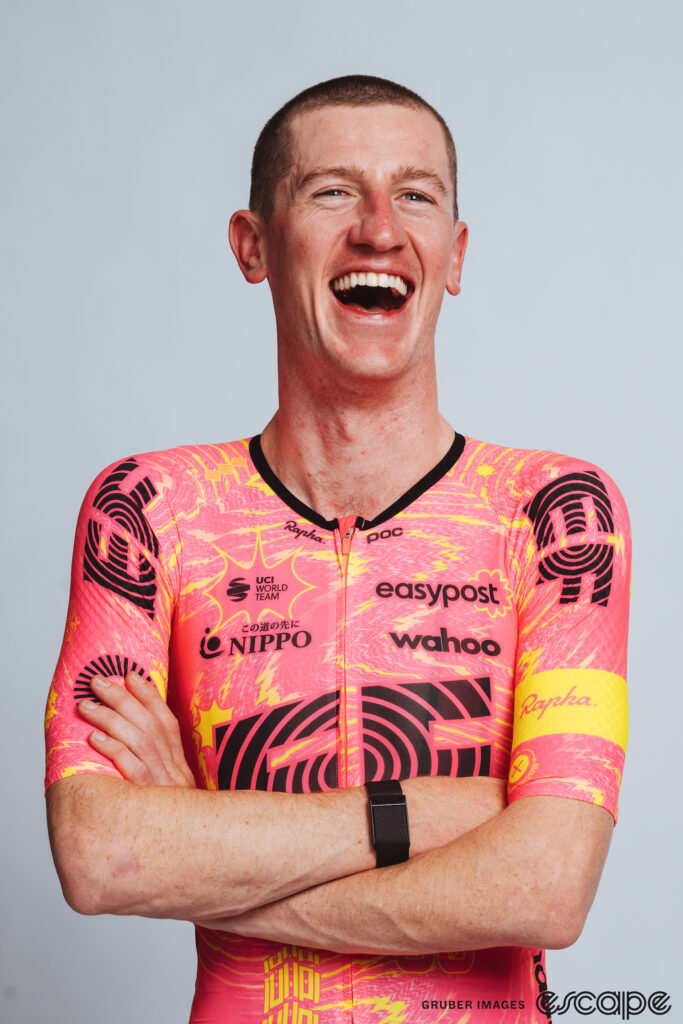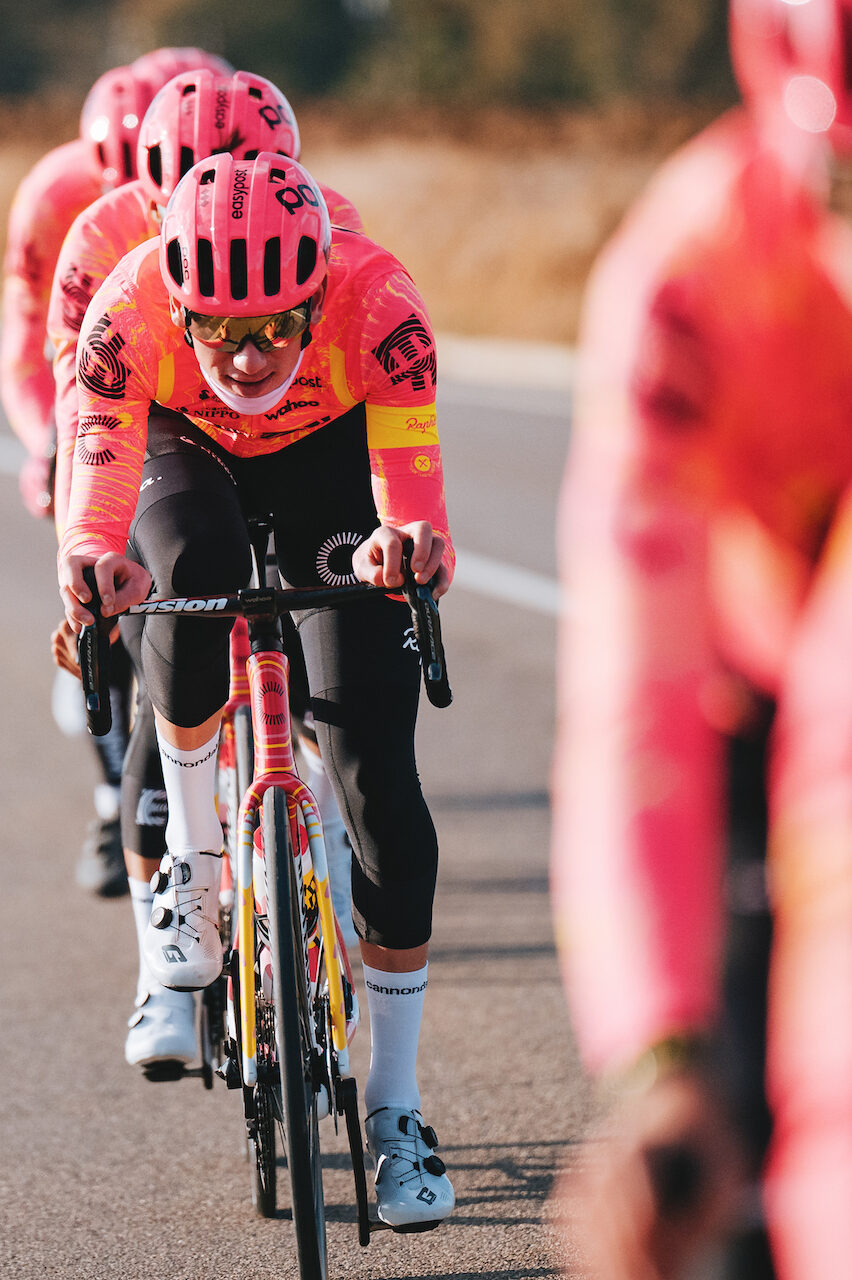“I believe that the sole reason I became a professional cyclist is because of how my brain is wired,” says Harry Sweeny, an Australian rider for EF Education-EasyPost. “The bits I am bad at I obsessively work at, and the bits I am good at I also obsessively work at to make sure I don’t lose that level. The way I could describe it for someone who is neurotypical is that it’s almost like an addiction without a drug: your brain craves to do things that, for want of a better term, is a special interest. Being neurodivergent is a massive benefit for me and my cycling, and this is one of the few sports where having an atypical brain is definitely really useful.”
American cycling greats Greg LeMond and Jonathan Vaughters, as well Germany’s Jan Ullrich, have all been diagnosed post-career as having a form of autism but, speaking with Escape Collective, 25-year-old Sweeny is believed to be the first active WorldTour rider to publicly announce that he is autistic, with the Queenslander revealing that he has ASD 1 – formerly but no longer referred to as Asperger’s.
But while Sweeny might be the first to go public, in reality he is very likely to be one of many neurodiverse athletes in the professional peloton. “My hypothesis is that on a symptomatic level, cycling is very appealing and attractive for someone with ADHD, and for those with ASD the planned structure that cycling necessitates is also very appealing,” says Professor Michael Liebrenz, chair of Forensic Psychiatry at the University of Bern and author of a number of studies on mental health in sports, including cycling.
Autism spectrum disorder (ASD), and its three levels, come under the umbrella term of neurodivergence, with ADHD (attention deficit hyperactivity disorder), dyslexia, OCD (obsessive compulsive disorder), and Tourette’s syndrome also among the list. The way our brains process information differs greatly, and this affects our behaviours and characteristics. Neurodiverse people excel under the right conditions, largely thanks to an ability to intensely focus on a specific task, but have a hard time in less-than-ideal environments, and commonly have problems with organising and communicating.
In a cycling context, it means that riders are able to cope with the rigorous demands of a highly-structured and often unsociable training schedule, and thrive at working towards one singular objective. They can, however, come across as confrontational in team meetings, and appear cold in public appearances, such as media interviews.
The prevalence of ASD in the general population is thought to be around 2%, while two to three times that amount of people are estimated to have ADHD – two distinct neurodevelopmental diagnoses but ones that often overlap. But at the elite level of sports, neurodivergence may be even more common; one 2021 study in the journal Sports estimated that up to 15% of athletes could have ADHD.

Though Sweeny might be a trailblazer in one sense, he and a growing but still limited number of studies agree that he is most definitely not alone in being an autistic cyclist competing at the highest echelons (and there may well be other pros who simply have opted not to share their diagnosis publicly). “There is more and more emerging research that people at the absolute pinnacle of their field are a lot more likely than the general population to have an atypical brain, and the more I’ve learned about it the more I can see that there are a shitload of pros who have autism but just don’t know,” Sweeny continues. “I think sport brings that out in people: to get to the top, alongside being incredibly talented, you need to have an obsession or hyperfocus on it, and there are a lot of my colleagues that I can see that in.”
Learning to refocus
As a child growing up in Warwick, Queensland, Sweeny’s parents never suspected signs of autism. “My mum said, ‘you couldn’t possibly be!’” But when they began to examine his childhood behaviour post-diagnosis, traits of autism became apparent. “As a kid I’d focus on a task so intently that I wouldn’t hear other people,” Sweeny recalls, “and because I was fascinated by building, I’d play with a hammer for five hours in the backyard. My parents thought it was what I liked, but looking back it was stereotypical hyperfocus.” There were other indications, too, such as a lack of empathy. “It would really grate against my being that my sister wouldn’t unpack the dishwasher when she was told to. I think my parents thought I was a little bit of a dick to her, but that’s how my brain worked.”
But it wasn’t until the summer of 2021, when he was 23, that Sweeny first contemplated that he might be neurodivergent. “I went to a Carrefour supermarket in Nice where I live, and all the lights and speakers were turned off or down. It felt really calm and I commented to my girlfriend how it was the first time I’ve ever felt relaxed while shopping. She Googled it and it said it was a Carrefour low-stimulant hour for autistic people. I looked up the definition of autism, we got speaking about it, but that was kinda it.”
After the completion of the 2022 season – his second as a WorldTour pro for Lotto-Soudal – Sweeny decided to get an assessment by a psychologist. “I remember the lady saying that it’s harder to detect autism in adults as they’ve made it so far in life without any diagnosis, but within 30 minutes she said, ‘yeah, if you’ve not realised already you have autism’. I went home and told my girlfriend that it was one of the best days of my life because not only does it make my life better now that I am learning more about myself, but it also helps everything to click and to make sense, such as to why I would become irrational or frustrated.” For example, that meant being aware of a decreased amount of sensitivity towards others. “Trying to understand someone else’s point of view is the biggest thing I struggle with, and before my diagnosis I had no concept of how someone could be upset about something if I wasn’t. Saying that out loud sounds real stupid, but someone with an atypical brain really can’t imagine that people think and perceive the world differently to them.”
Sweeny joined EF on a three-year contract this past winter, and his new team’s boss, Jonathan Vaughters, told Cycling Weekly magazine earlier this year that “for someone with Asperger’s [now referred to as ASD 1], if only 95% of the details are in place, they will wonder how on earth they can be expected to do their best, caught up on the 5% that is wrong.” Sweeny, who like Vaughters has ASD 1, concurs: “If one of my feet or muscles hurt, 100% of my brain power goes into thinking about that,” he says. “A lot of the work I’ve been doing for the last two years with a sports psychologist has been learning how to refocus and developing techniques to help the brain get around the negative side of it all.” Conversely, however, that fixation on one single issue can also be a positive. “It might be the latest best method for zone 2 training, supplement regime or whatever it is, but if my interest is piqued, I’ll read all the facts, read the actual studies and buy into it wholeheartedly. That dedication to having factual-based information to go off is really beneficial. The way I see it is that having autism is more of a strength than a weakness, especially the hyperfocus, motivation, and problem solving.”

What Sweeny says resonates with LeMond. The three-time Tour de France winner was diagnosed with ADD – attention deficit disorder – 25 years ago, shortly after his son, Scott, received a similar diagnosis. “I didn’t like school and had a hard time paying attention, but when I got into cycling all of a sudden my brain opened up and I started to enjoy learning, because when you’re exercising so many things are coming into your head that it improves your focus and calms your brain down,” LeMond says. “I have a hyperfocus: I really get into everything I do and read all the books, and that’s helped me a lot. At the same time, if I’m not interested in something, I won’t pay any attention to it.”
It was his ADD, he believes, that prompted him to think outside the box. “I’ve always been curious and had an ability to think and be creative,” he continues. “The reason I used glasses and triathlon bars was because I was curious, and that was part of my ADD. I also believe that it gave me a huge advantage tactically because you have to think about a lot of things at once, and I could do that. I watched some riders make idiotic moves, and I think I raced smarter than most.”
LeMond admits that there are downsides to the way his brain functions. “I find myself talking to people and I’m confusing them as I’m thinking about four or five different topics at once,” he laughs. “I also have some organisational problems and lose track of the time, but I have a system in place to manage that. Believe it or not, ADD people like structure. When I was in the off-season trying to recover, I wasn’t lost, but I operated much better when I got back into structured training. ADD people thrive in war and intense battles, and it’s the same with cycling as it keeps the brain alive and provides structure.” It’s no surprise, then, that LeMond would “bet that there is a bigger percentage of people in cycling with ADD than the general population, because those with ADD are thrillseekers, they like stimulation and cycling is the best thing for that.”
But does the research, and the science, back up the belief that being neurodivergent is a benefit to athletes? A systematic review of existing studies on neurodiversity in elite sport, published in the BMJ in 2023, assessed that while the ADHD characteristics of “hyperfocus and rapid reaction to changing stimuli… are likely to be highly advantageous in elite sport settings,” studies to date have also concluded that “ADHD has been examined as a risk factor for previous and future concussion.”
Moreover, a 2019 study in the British Journal of Sports Medicine said that “oppositional behaviour, argumentative attitude… and labile mood found in ADHD may impair athletic performance,” while also writing that “a literature review found that of ADHD, mood disorders and substance use disorders, co-occurence of two of these disorders was commonly reported in adults athletes with ADHD.” Very little research has been conducted into the effects of ASD on elite athletes.
Professor Liebrenz says that cycling is appealing for those with ADHD, such as LeMond, because they have a “tendency to move, to be impulsive, and though they can be easily distracted, when they have a downhill at 100 km/h on 25 mm tyres, they have to really focus on something, and they thrive on that. Also, they like to suffer, and they can generate that pain sensation through the sport of cycling. On the autism side, they like that cyclists have to have a planned structure for every hour of the day.” But, Liebrenz adds, difficulty with communication, something often experienced by those with ASD, works against autistic cyclists. “They have more issues with engaging in relationships and this is unhelpful as a professional sportsperson,” he says. “They can be offensive to the press which upsets sponsors and teamwork, and that’s why I think cyclists are more likely to have ADHD than ASD.”
Are elite athletes more likely to be neurodiverse?
There has been next to no research comparing the rates of neurodiversity between individual and team, and endurance and power sports. Frustratingly, Alexander Smith, also of the University of Bern, explains how only 13 mental health studies into professional cycling have ever been conducted. The depth of research just doesn’t exist, and thus the current debate around neurodivergence mainly relies on anecdotal tales. American bike brand Specialized, however, have been working to understand the relationship between neurodivergence and cycling, particularly in children, since 2015 when they launched their Outride foundation. (Specialized founder Mike Sinyard has been diagnosed with ADHD.)
Some studies have attempted to put a number on the prevalence of neurodiverse athletes in elite sport, such as the 2019 British Journal of Sports Medicine study, which estimated that 7-8% of elite athletes have ADHD, while a widely-cited 2018 review of studies claimed that up to 14.3% of young athletes worldwide could have ADHD, with a lower-bound estimate of 4%, underscoring the uncertainty about prevalence). A potential factor for the higher prevalence is the fact that athletic activity increases neurotransmitters in the brain, something which reduces ADHD symptoms for a period of time, and is therefore appealing to those with ADHD who are looking for an outlet for their excess energy (this is a core focus of Outride’s work). “Their hyperactivity is compensated by their cycling,” Liebrenz says. “They can come back from a six-hour ride and not be nervous or twitchy, not be shaking, not rocking on the chair, and it’s because they’ve just been on a bike for half the day. When you take that away from them after they retire, all this stuff gets de-masked, and the ADHD becomes more obvious.”
Without much hard data, most of what we have to go on are hunches, if ones with expert perspective. Vaughters, for instance, has previously said that both ASD and ADHD are “fairly common in pro cycling” and Sweeny says that “being a good pro is characterised as training properly and being obsessive, and there’s definitely some overlap with being neurodivergent.” We most often refer to this as perfectionism, but Sweeny points out “that’s not always the right term – I don’t want to categorise half the peloton, but it might be that they’re actually neurodivergent.”


While there is scant evidence to back up the anecdotal claims, the general consensus is that those who are neurodiverse – and particularly ADHD or ASD 1, often termed as a high-functioning form of autism – are more likely to select an endurance activity like cycling as their principal sport, and though how their brains are wired can cause issues and conflict, that laser-intent focus that they possess usually benefits the pursuit of cycling, and gives them a greater chance of succeeding.
“The reason I agreed to [go public] is not because I feel I have a responsibility, but because I feel like it could only be a good thing coming out with this, and show to the world that being neurodivergent can have a really positive impact on your life,” Sweeny says. “When you compare those studies [that claim autism is more common among elite athletes] to the general population, it really starts to give you an idea that it’s not just a coincidence but that there are a lot of neurodivergent people in high-performing areas.
“When I was diagnosed it was a mind blowing experience to learn that the autistic spectrum is not linear. It’s more like a circle, and you can come out there to being very autistic in some areas, but in other areas you’re not. There’s a myth to what people think autism is: they think you’re really autistic or you’re not, but for me personally there are things I couldn’t care less about, and others I care a lot about. That’s why I didn’t recognise it earlier.
“I never imagined myself having something like this, so then to learn more about it and to see it is probably the way I am in the first place, and the reason I became a pro, could be really useful for other people. There is a lot of misconception that autism is a negative thing – but it’s not a diagnosis, it’s just that you think differently. I only see being autistic as overwhelmingly positive.”
Did we do a good job with this story?


